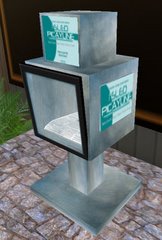by Owen KellyEditor's note: Two thoughtful posts by our Finnish colleague, Owen.JUNE 7I followed the RL in SL thread with mounting interest, because it beganto occur to me that almost everyone who answered appeared to beinterested in using SL as a way of augmenting their current RL teachingpractices. "Why can't we just be ourselves? People should be chargedextra for using it as a fantasy world! And so on"
This approach seems to me to see SL as a better version of WebCT orWhiteboard: a neater, trendier way to capture students' interests. Hence the need, in a recent thread, to ask how people justify using SL: a very pertinent question since IMHO SL has very dubious added value for this approach.
I would make an analogy with the introduction of television into schoolsas an "educational medium". There was a period when people thought thatyoung people were interested in television and therefore it should beintroduced into the classroom. So the educational policy makerspersuaded the BBC and others to create sensible "educational TV" that students were unaccountably uninterested in. Other people immersedthemselves in the medium and realised that you could learn/teach a lotby taking it as it already was, even by asking about what HuckleberryHound could show us about perception, and so on.
Are we (at Arcada in Helsinki, Finland) the only people here who aretrying to develop immersive educational uses for SL - trying to use itto develop teaching approaches that WebCT is simply not made to do orunable to do?
I ask because if other people are pursuing immersive pedagogical goals here then I would very much like to swap information (here or offlist,or a mixture of both).
We have been engaged in a long term attempt to create a coherent virtual culture, and Caledon (which someone mentioned in the RL -> SL thread) might well be an example of the kind of thing we have been talking about.
It is a conceptual space with an internal consistency that renders some behaviours appropriate, and rewards such behaviour by increased immersion.
To parallel a question posed in the previous thread: does anyone here know who Ordinal Malaprop is in "real life"? I suspect not, because she too is an immersionist. Her contributions to SL, which are many, do not derive their authority from her RL credentials, and I see no reason why they should. To wonder what she has to hide is just plain silly. She has found a way of playing creatively that does not get intertwined with her personal and professional issues, and she has used this opportunity well. Her abilities speak for themselves. How would I benefit by knowing whether she was a kindergarden teacher, a chemistry researcher or a professional wrestler?
Another example of this approach would be Edward Castrovalva's Shakespeare World, where people will be required to *be* characters in aworld that lives by natural laws derived from Shakespeare's world view.
This kind of approach seems to me to offer astounding opportunities to explore potential new pedagogical areas well beyond traditional classroom role playing. From this perspective Linden Labs have not got it backwards at all.
I could be wrong, but I feel that it is important to find out and I don't see how I can do that by using SL "sensibly".
JUNE 6...I don't think giving out personal information is a question of being rude or not being rude; nor do I think it is a question of being safe or not being safe. It is a question of whether you are an
immersionist or an
augmenter.
When we joined in 2005 SL was primarily an immersivist environment. People entered the "world" and adopted a persona of some kind that might or might not have a direct correlation to their everyday real personality. People built up friendships in the world with the characters they found there, on the basis of how they felt about them. Some people (for whatever reason) adopted furry personae, and whether they were treated well or treated badly they were treated like furries. Nobody was interested in who or what they "really" were.
In this way people became well-known in SL for the things they brought to the party: building or scripting skills; a willingness to host parties every night; the size of their personal networks, and so on.
This approach (which we have tended to continue with) means that students adopt personae and work with other students in SL without knowing who (in real life) they are working with. They may also pick up strangers who help them, without knowing who they "really" are. I have a student at the moment - Kittie Ellison - who has been taught a lot of scripting and advanced building skills by someone whose real world identity is unknown to her or to me. She is now using them in her coursework, without having talked to her benefactor about being a student or needing to do course work.
In this approach (which was I believe how SL started) people agree to immerse themselves in a collective fantasy by playing pretend charactersin a communally created ongoing narrative.
More and more though SL is moving towards an augmental approach, where SL is used as a tool by real life people to augment their real life activities, by providing another communications channel. I describe this as Skype-with-puppets, and I suspect that the introduction of voice, and the new id requirements, will rapidly increase the number of people joining SL to use it in this way. For these people their SL name is merely a "handle" of the sort that have existed for years on bulletin boards and in discussion forums.
Handles (like angryBOY or cakelover) are not supposed to be identities. They are shortcuts that might tangentially say something allegedly amusing about the people adopting them. They are transient conveniences, and can be dropped or changed at any time. Unlike the immersionist approach these handles do not gain a personal history and a personal status.
I met my first full-strength augmenter in SL last week. He said, "Hi I am [some name]. I used to be [different name] but that account doesn't work any more". For him apparently, "he" (the real life he) was in SL, and the name he used was just a handle. He was, of course, not just happy but positively eager to tell me what the weather was like on the East Coast just then. This is in stark contrast to many older residents for whom their character had a separate (albeit parallel) existence, and was not at all interested in the weather in New York, but focused entirely on the world inside Second Life.
When I first joined I was told that giving out personal information spoiled the fantasy, and should be avoided for that reason. That is only of any importance, though, if there is a reason to think that the fantasy itself is important. Personally I do think that there are very interesting pedagogical avenues to explore in an immersionist world, but this approach may not suit many people; and may not even be possible in many institutions. It may not even be possible in Second Life much longer, and we have begun to think of ways of modifying our approach in the light of the changes in the SL environment.


